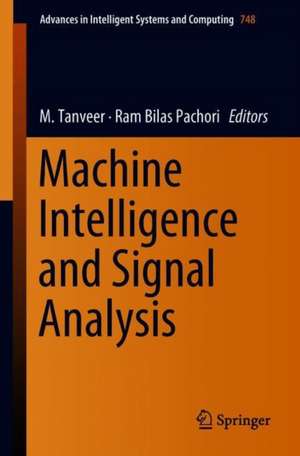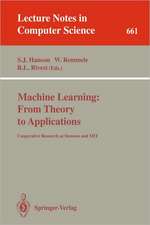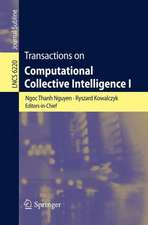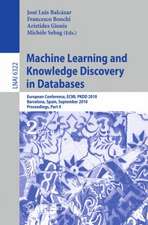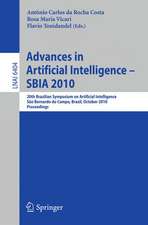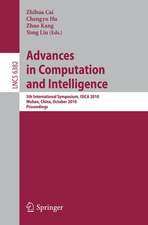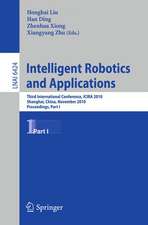Machine Intelligence and Signal Analysis: Advances in Intelligent Systems and Computing, cartea 748
Editat de M. Tanveer, Ram Bilas Pachorien Limba Engleză Paperback – 8 aug 2018
Din seria Advances in Intelligent Systems and Computing
- 70%
 Preț: 395.69 lei
Preț: 395.69 lei - 20%
 Preț: 1090.59 lei
Preț: 1090.59 lei - 20%
 Preț: 1324.07 lei
Preț: 1324.07 lei - 20%
 Preț: 758.57 lei
Preț: 758.57 lei - 20%
 Preț: 1989.79 lei
Preț: 1989.79 lei - 20%
 Preț: 1946.92 lei
Preț: 1946.92 lei - 18%
 Preț: 1273.28 lei
Preț: 1273.28 lei - 20%
 Preț: 2264.51 lei
Preț: 2264.51 lei - 20%
 Preț: 1337.27 lei
Preț: 1337.27 lei - 20%
 Preț: 1297.67 lei
Preț: 1297.67 lei - 20%
 Preț: 1315.82 lei
Preț: 1315.82 lei - 20%
 Preț: 1310.88 lei
Preț: 1310.88 lei - 20%
 Preț: 1302.62 lei
Preț: 1302.62 lei - 20%
 Preț: 882.19 lei
Preț: 882.19 lei - 20%
 Preț: 1305.93 lei
Preț: 1305.93 lei - 20%
 Preț: 1629.32 lei
Preț: 1629.32 lei - 20%
 Preț: 1345.49 lei
Preț: 1345.49 lei - 18%
 Preț: 1227.52 lei
Preț: 1227.52 lei - 18%
 Preț: 1290.64 lei
Preț: 1290.64 lei - 20%
 Preț: 1041.10 lei
Preț: 1041.10 lei - 20%
 Preț: 1034.52 lei
Preț: 1034.52 lei - 20%
 Preț: 1298.50 lei
Preț: 1298.50 lei - 20%
 Preț: 1330.67 lei
Preț: 1330.67 lei - 20%
 Preț: 1483.28 lei
Preț: 1483.28 lei - 20%
 Preț: 1971.64 lei
Preț: 1971.64 lei - 20%
 Preț: 1006.48 lei
Preț: 1006.48 lei - 20%
 Preț: 1471.75 lei
Preț: 1471.75 lei - 20%
 Preț: 1471.56 lei
Preț: 1471.56 lei - 20%
 Preț: 1454.40 lei
Preț: 1454.40 lei - 20%
 Preț: 1494.84 lei
Preț: 1494.84 lei - 20%
 Preț: 1269.64 lei
Preț: 1269.64 lei - 20%
 Preț: 1481.64 lei
Preț: 1481.64 lei - 20%
 Preț: 1192.08 lei
Preț: 1192.08 lei - 20%
 Preț: 1298.50 lei
Preț: 1298.50 lei - 20%
 Preț: 1489.07 lei
Preț: 1489.07 lei - 20%
 Preț: 825.78 lei
Preț: 825.78 lei - 20%
 Preț: 1649.93 lei
Preț: 1649.93 lei - 20%
 Preț: 1463.49 lei
Preț: 1463.49 lei - 20%
 Preț: 1268.80 lei
Preț: 1268.80 lei - 20%
 Preț: 1474.22 lei
Preț: 1474.22 lei - 20%
 Preț: 1298.50 lei
Preț: 1298.50 lei - 20%
 Preț: 1327.35 lei
Preț: 1327.35 lei - 20%
 Preț: 1973.31 lei
Preț: 1973.31 lei - 18%
 Preț: 947.04 lei
Preț: 947.04 lei - 18%
 Preț: 1441.39 lei
Preț: 1441.39 lei -
 Preț: 503.54 lei
Preț: 503.54 lei - 20%
 Preț: 638.55 lei
Preț: 638.55 lei - 20%
 Preț: 1320.76 lei
Preț: 1320.76 lei
Preț: 1295.86 lei
Preț vechi: 1619.82 lei
-20% Nou
Puncte Express: 1944
Preț estimativ în valută:
248.03€ • 255.60$ • 209.39£
248.03€ • 255.60$ • 209.39£
Carte tipărită la comandă
Livrare economică 01-15 martie
Preluare comenzi: 021 569.72.76
Specificații
ISBN-13: 9789811309229
ISBN-10: 9811309221
Pagini: 738
Ilustrații: XX, 767 p. 301 illus., 224 illus. in color.
Dimensiuni: 155 x 235 mm
Greutate: 1.08 kg
Ediția:1st ed. 2019
Editura: Springer Nature Singapore
Colecția Springer
Seria Advances in Intelligent Systems and Computing
Locul publicării:Singapore, Singapore
ISBN-10: 9811309221
Pagini: 738
Ilustrații: XX, 767 p. 301 illus., 224 illus. in color.
Dimensiuni: 155 x 235 mm
Greutate: 1.08 kg
Ediția:1st ed. 2019
Editura: Springer Nature Singapore
Colecția Springer
Seria Advances in Intelligent Systems and Computing
Locul publicării:Singapore, Singapore
Cuprins
Chapter 1: Detecting R-peaks in Electrocardiogram signal using Hilbert envelope.- Chapter 2: Lung Nodule Identification and Classification from Distorted CT Images for Diagnosis and
Detection of Lung Cancer.- Chapter 3: Baseline wander and power-line interference
removal from ECG signals using Fourier decomposition method.- Chapter 4: Baseline wander and power-line interference removal from ECG signals using Fourier decomposition method.- Chapter 5: An Empirical Analysis of Instance-based Transfer Learning Approach on Protease Substrate Cleavage Sites Prediction.- Chapter 6: Comparison analysis: single and multichannel EMD based filtering with application to BCI.- Chapter 7: A 2-norm Squared Fuzzy-based Least Squares Twin Parametric-margin Support Vector Machine.- Chapter 8: Redesign of a Railway Coach for Safe and Independent Travel of Elderly.
Notă biografică
M. Tanveer is working as Assistant Professor and Ramanujan Fellow at Discipline of Mathematics, Indian Institute of Technology Indore, India. Prior to that, he worked as Postdoctoral Research Fellow at Rolls-Royce@NTU Corporate Lab, Nanyang Technological University (NTU), Singapore. He served as Assistant Professor at Department of Computer Science and Engineering, LNM Institute of Information Technology (LNMIIT), Jaipur, India. He received his Ph.D. degree in Computer Science from the Jawaharlal Nehru University, New Delhi, India, and his M.Phil. degree in Mathematics from Aligarh Muslim University, Aligarh, India. His research interests include support vector machines, optimization, applications to Alzheimer’s disease and dementias, biomedical signal processing, and fixed-point theory and applications. He has been awarded competitive research funding by various prestigious agencies such as Department of Science & Technology (DST), Council of Scientific and Industrial Research (CSIR) and Science & Engineering Research Board (SERB). He is the recipient of 2017 SERB Early Career Research Award in Engineering Sciences and the only recipient of 2016 prestigious DST-SERB Ramanujan Fellowship in Mathematical Sciences. He is a member of the editorial review board of Applied Intelligence, Springer (International Journal of Artificial Intelligence, Neural Networks, and Complex Problem-Solving Technologies). He has published over 24 papers in reputed international journals.
Dr. Ram Bilas Pachori received B.E. degree with honors in Electronics and Communication Engineering from Rajiv Gandhi Proudyogiki Vishwavidyalaya, Bhopal, India in 2001, M.Tech. and Ph.D. degrees in Electrical Engineering from Indian Institute of Technology (IIT) Kanpur, India in 2003 and 2008 respectively. He worked as Postdoctoral Fellow at Charles Delaunay Institute, University of Technology of Troyes, France during 2007-2008. He served as Assistant Professor at Communication Research Center, International Institute of Information Technology, Hyderabad, India during 2008-2009. He served as Assistant Professor at Discipline of Electrical Engineering, IIT Indore, India during 2009-2013. He worked as Associate Professor at Discipline of Electrical Engineering, IIT Indore, Indore, India during 2013-2017 where presently he has been working as Professor since 2017. He worked as Visiting Scholar at Intelligent Systems Research Center, Ulster University, Northern Ireland, UK during December 2014. His research interests are in the areas of biomedical signal processing, non-stationary signal processing, speech signal processing, signal processing for communications, computer-aided medical diagnosis, and signal processing for mechanical systems. He has more than 125 publications which include journal papers, conference papers, book, and book chapters.
Dr. Ram Bilas Pachori received B.E. degree with honors in Electronics and Communication Engineering from Rajiv Gandhi Proudyogiki Vishwavidyalaya, Bhopal, India in 2001, M.Tech. and Ph.D. degrees in Electrical Engineering from Indian Institute of Technology (IIT) Kanpur, India in 2003 and 2008 respectively. He worked as Postdoctoral Fellow at Charles Delaunay Institute, University of Technology of Troyes, France during 2007-2008. He served as Assistant Professor at Communication Research Center, International Institute of Information Technology, Hyderabad, India during 2008-2009. He served as Assistant Professor at Discipline of Electrical Engineering, IIT Indore, India during 2009-2013. He worked as Associate Professor at Discipline of Electrical Engineering, IIT Indore, Indore, India during 2013-2017 where presently he has been working as Professor since 2017. He worked as Visiting Scholar at Intelligent Systems Research Center, Ulster University, Northern Ireland, UK during December 2014. His research interests are in the areas of biomedical signal processing, non-stationary signal processing, speech signal processing, signal processing for communications, computer-aided medical diagnosis, and signal processing for mechanical systems. He has more than 125 publications which include journal papers, conference papers, book, and book chapters.
Textul de pe ultima copertă
The book covers the most recent developments in machine learning, signal analysis, and their applications. It covers the topics of machine intelligence such as: deep learning, soft computing approaches, support vector machines (SVMs), least square SVMs (LSSVMs) and their variants; and covers the topics of signal analysis such as: biomedical signals including electroencephalogram (EEG), magnetoencephalography (MEG), electrocardiogram (ECG) and electromyogram (EMG) as well as other signals such as speech signals, communication signals, vibration signals, image, and video. Further, it analyzes normal and abnormal categories of real-world signals, for example normal and epileptic EEG signals using numerous classification techniques. The book is envisioned for researchers and graduate students in Computer Science and Engineering, Electrical Engineering, Applied Mathematics, and Biomedical Signal Processing.
Caracteristici
Presents the latest advances in the area of data mining, artificial intelligence, optimization, machine learning methods and algorithms Discusses applications for studying human brain and heart disorders like epilepsy, Alzheimer’s, and coronary artery disease Serves as a valuable reference resource for future work
